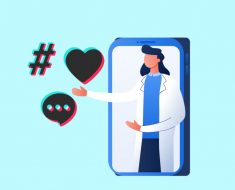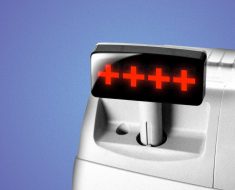This is the second feature in a two-part series.
An ENT exam to check out a climbing injury to the chest. A knee replacement after a motorcycle wreck. Mike Hill was no stranger to the doctor’s office over the last 2 months. But even with his fair share of injuries, the 50-year-old police officer felt great.
That’s why Hill’s diagnosis in January 2022 came as a shock. The only person more shocked than Hill was his surgeon.
“He just kept asking, ‘How are you here?’ ” Hill remembered. “We never find this.”
The head and neck specialist was referring to the stage II squamous cell carcinoma in Hill’s tonsils. Patients with this type of cancer are rarely identified before stage IV when their neck is swollen, or they can’t swallow. And then it’s too late.
But Hill was lucky. Although a recent CT scan, full body MRI, and the ENT exam after his climbing accident had found no hint of cancer, a new blood test called Galleri spotted it.
Hill is one of more than 5000 Arizona-based first responders with access to this blood test and other cancer screening options through a government-funded program. Radiation oncologist Vershalee Shukla, MD, co-founder of Scottsdale’s Vincere Cancer Center, sits at the helm of the program, which started in October 2018 as a low-budget effort to screen local firefighters for cancer, and later transformed into a multipronged program offering advanced cancer screening tests.
These tests include standard cancer screenings, like mammograms and colonoscopies, at younger ages, alongside more advanced workups, such as whole-body MRIs and QT breast scans.
In 2021, Shukla added the Galleri liquid biopsy test from Grail Bio to the list of screening options. The blood test can identify 50 types of cancer by picking up cancer-related methylation patterns in free-cell DNA.
The results are binary: a negative or positive signal for cancer. And if positive, the test indicates where that cancer might be lurking.
The aim of this test is to catch cancers sooner, especially those with no available screening tests. Priced at $950 per test and yet to be validated by the FDA, the Galleri test is controversial and is yet not part of standard cancer screening.
Shukla decided to incorporate this blood test into her screening program because she wanted all tools at her disposal to root out cancer in this high-risk population.
“The problem with [first responders] is they get cancer young,” as much as 10 years earlier than the general population and often rarer forms, Shukla said.
Program’s Origins
The city-funded cancer screening program in Scottsdale was set in motion by tragedy.
In May 2019, firefighter Bryan Beck Jr died of stage IV melanoma at age 31. The advanced skin cancer, diagnosed a little over a year earlier, had been the product of 8 years of running into carcinogen-laden infernos with Phoenix Fire, alongside his father and uncles.
Beck left behind a wife and three small children: an incalculable loss. The cost to the city of Phoenix, however, could be measured: A $5 million settled worker’s compensation claim, sources in city government told Medscape Medical News.
The payout, which Beck’s family received shortly before he died, left city leaders panicked, according to Michael Petersen-Incorvaia, then assistant to Phoenix councilwoman Laura Pastor. Fighting fires comes with heightened cancer risk, and a few more claims like Beck’s would bankrupt the city.
One night at dinner, Petersen-Incorvaia posed a question to councilwoman Pastor and Shukla: How much would screening every firefighter in Phoenix cost?
Shukla’s estimate, based on her experience screening and treating advanced disease: keeping one firefighter with advanced cancer alive would cost the same as screening every firefighter in the city — about half a million dollars.
At that point, there was no question what their next step had to be, Peterson-Icorvaia recalled. The city would invest in the screening program that Shukla had established 6 months earlier.
Shukla started this effort to screen firefighters in October 2018, largely on her own dime.
In the early months of the program, as word about low-to-no-cost cancer screenings spread, firefighters from around the state flocked to the Vincere Cancer Center. The building was packed each week on Fireman Fridays where the first responders could receive low-dose lung CTs, colonoscopies, and genetic testing.
“[I did] as much as I could do as cheaply as I could do it,” Shukla said.
The overwhelming turnout made it clear: The firefighters knew their cancer odds weren’t good, and many felt helpless.
In late spring 2019, the Phoenix city council decided to infuse $3 million a year to screen all city employees, with priority given to first responders. This money allowed Shukla to upgrade her low-budget program to include a more robust, annual screening with colonoscopies before age 45, QT ultrasounds for breast cancer, as well as whole-body MRIs typically not covered by insurance.
Police received priority alongside firefighters because officers like Mike Hill (the stage II SCC survivor) often end up at the same emergencies as firefighters, just wearing less protection. Soon, nine other cities joined forces with Vincere to screen their fire departments.
In May 2021, Grail Bio approached Shukla about adding the Galleri blood test to the mix. Shukla was already aware of the test and decided to add it to the screening options, reallocating some of the funds for bloodwork toward the liquid biopsy test.
“We need a test like this” for high-risk first responders that can help identify rare cancers, like Hill’s, earlier, she said.
A Worthy Public Health Investment?
Shukla’s cancer screening program offers a host of tests alongside Galleri.
Prostate exams are typically offered at age 40 unless the person is on testosterone. Women can receive QT breast exams as early as age 30 and mammograms at 40. Colonoscopies begin at age 35. And in Phoenix, after 5 years of service, first responders can get a whole-body MRI.
So far, this combination of screening tests has caught 126 cancers — including the previous fire chief’s.
Each person’s regimen is determined after Shukla assesses their risk factors and family history, and each city’s program and budget are different. Some cities, for instance, only cover Galleri blood tests for firefighters.
Shukla’s goal is to screen every first responder with Galleri once. One primary advantage of the test is its efficiency, she said. Firefighters get their blood drawn at the firehouse and results a few weeks after that. Other screening efforts take more time and scheduling. Colonoscopies, for instance, require days of prep. Some firefighters need sedation before an MRI, which can leave them groggy. And other tests expose people to radiation.
Over 18 months, the city of Phoenix has run almost 1500 Galleri tests, and another 500 firemen have received a test at a nearby Mesa center. Shukla has been able to catch two cancers early with the help of the blood test: Hill’s throat cancer and a rare bone cancer in another first responder.
According to Grail Bio, the primary aim of Galleri is to detect aggressive cancers like Hill’s early, particularly for cancers that have no other available screening options.
However, Galleri results are not guaranteed. The test doesn’t detect all 50 cancers with the same specificity and selectivity. Plus, it can miss cancers that are there or detect ones that aren’t, Shukla said.
That’s why Shukla never uses Galleri on its own; the test is just one small part of the more comprehensive screening program at Vincere. And she’s careful to educate every patient about the test’s limitations — a negative result doesn’t mean you’re in the clear and a positive result doesn’t mean you have cancer.
Still, Ishani Ganguli, MD, MPH, who researches the cascade of screening and diagnostic tests needed to identify cancer, cautioned that more testing isn’t necessarily better.
“I get the appeal. It feels like you’re doing something helpful for important people,” said Ganguli, a general internist at Harvard Medical School and Brigham and Women’s Hospital in Boston.
But, in general, additional screening and imaging aren’t as helpful as they may seem, she explained. “The trade-off much more often is the whole-body scan will find something that isn’t a problem,” Ganguli said. “These findings are very often not meaningful but lead to additional cascades of treatment that are more stressful for patient and doctor.”
And although more testing won’t financially burden the first responders in this program, it will be felt by taxpayers and the community, she said. A better approach for first responders, she said, would be to make sure they all have insurance and a diligent primary care doctor.
Epidemiologist Electra Paskett, PhD, believes Shukla’s approach is “kind of novel” because a lot of these tests she offers, like the whole-body MRI and liquid biopsy, are not mainstays for the average person.
“I think it’s wonderful, but there are many caveats,” noted Paskett, a cancer screening expert at Ohio State University in Columbus.
Some of these advanced or newer screening tests, such as Galleri, are not as well studied as the cornerstone tests like colonoscopy and mammogram, and “we are not sure of their widespread usability.” And Paskett agreed with Ganguli that doing many additional tests on top of the standard screening tests runs the risk of becoming overkill — burdening patients more than necessary.
“Cancer screening is tough, it’s hard to do, it’s anxiety-provoking,” Shukla agreed. But even at this stage, Shukla believes that Galleri and other advanced screening tests are worth doing in such a high-risk, poorly understood patient group.
For instance, when Hill’s test came back with a positive signal for cancer, it suggested head and neck cancer that a previous MRI and CT had missed. When Shukla ordered an MRI with contrast, the tumor was there plain as day, she said.
On the financial side, Shukla noted that detecting even a few cancers early each year means the program essentially pays for itself, given the cost of treating more advanced cancers as well as the potential for a future workers compensation payout.
As for the first responders themselves, the half dozen that Medscape spoke to for this story had varied screening results and opinions on the tests offered by Vincere. But they all shared a deep gratitude for Shukla’s support through the process.
In Hill’s case, the Galleri test was lifesaving, but he only took it because it was free. And although stressful, Hill said Shukla’s support through his cancer journey helped him manage the fear and anxiety. From diagnostics to surgery to physical therapists, she made the appointments, advised his treatment decisions, and remained available 24/7 at her personal number.
Scott Durkee, public health officer for Phoenix Fire, expressed a similar sentiment. “Having Dr Shukla on my side means I have a 100% increase in managing my cancer risk because I wasn’t really managing it before,” said Durkee. “If we have this opportunity, we should not be disrespecting our fallen brothers and sisters.”
Shukla reported no conflicts of interest related to her screening program; she has received several government grants to fund the screening services for first responders.
Donavyn Coffey is a Kentucky-based journalist reporting on healthcare, the environment, and anything that affects the way we eat. She has a master’s degree from NYU’s Arthur L. Carter Journalism Institute and a master’s in molecular nutrition from Aarhus University in Denmark. You can see more of her work in Wired, Scientific American, Popular Science, and elsewhere.
Source: Read Full Article





